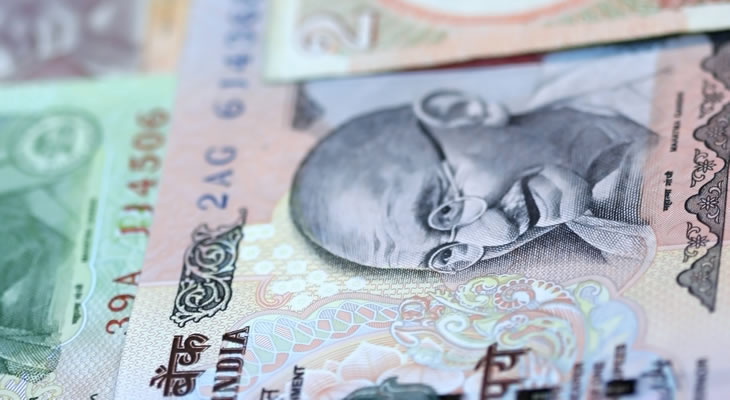- Pound Indian Rupee Exchange Rate Strays Southward – Falling oil and BOE statements place downward pressure on the pairing.
- Falling Oil sees Positive Movement for Importer India’s Currency – Relying on imports to top up oil inventories, cheaper oil bodes well for the Rupee.
- Bank of England Governor Mark Carney makes case for Imminent Economic Stimulus – Some analysts even predict a rate cut next week.
- GBP/INR Pairing Sits in the Hands of Policymakers as they attempt Brexit Damage Control
The Pound Indian Rupee exchange rate jumped briefly yesterday but has restarted its downward slide as oil looks to drop further.
A data report coming from India showed the budget deficit had almost doubled compared to last month, placing downward pressure on the Indian currency and allowing the Pound Indian Rupee exchange rate to rally by around half a Rupee.
However, as Bank of England Governor Mark Carney took to the stage to announce the likelihood of near-term economic stimulus, the prospect of upcoming rate cuts saw the Pound drop across the board and the GBP/INR rate fell by over one Rupee.
Currently the Pound Indian Rupee exchange rate trades at 89.6750, seeing very little movement thus far in today’s session.
Sterling (GBP) Feels Downward Pressure as BOE’s Carney sets out Near-Term Stimulus
The Pound has been dealing with unprecedented depreciations since the UK voted to exit the European Union on the 23rd of June. Sterling witnessed its largest single-day slide and dropped as much as 10% against the majors.
Uncertainty continues to permeate the economic and political landscapes of Britain as the Brexit has led to Prime Minister David Cameron’s resignation and a divided Tory party attempting to dredge up some form of leader. Jeremy Corbyn’s Labour shadow cabinet experienced a mass exodus as over two-thirds of his ministers resigned, citing the lacklustre campaign to remain in the EU and concerns Corbyn lacks the leadership to take the party forward.
The UK’s manufacturing PMI printed comfortably above forecasts at 52.1 but failed to have any noticeable impact whatsoever on the British currency apart from possibly stemming downward pressure a little.
The Pound has continued to drop across the board during today’s session, seeing drops as large as 0.75% against the New Zealand and Australian Dollar on the back of Governor of the Bank of England Mark Carney’s comments yesterday.
Carney took to the stage to announce that the central bank will be eyeing economic stimulus in the near-term and some analysts posit the bank may even cut rates as soon as next week’s July policy meeting.
Indian Rupee (INR) Fails to Rally Substantially as Ecostats Disappoint
Oil price declines over the past two days have placed upward pressure on the Rupee as the currency battles against depreciation due to the recent surge in gold value.
India, historically, is an import nation and as such the prices of oil, gold and other commodities have a marked impact on the Indian Rupee. As oil falls, the Rupee gains as India places huge demand on black gold imports to top up reserves. The same goes for gold, even for all its practical uses, gold is sentimentally and culturally important in India and as a result the nation has to import a great deal.
Indian data prints have proved rather disappointing this week with the government’s public finance deficit doubling compared to last month after a period of sequential reduction. The Indian infrastructure output report, which functions similar to a composite PMI, also failed to impress and missed forecasts by over 4%.
Forecasts for Pound Indian Rupee Exchange Rates Hinge on Further Policy Changes
The Pound’s future continues to be in the hands of policymakers as they work to stem the UK’s economic woes. The confirmation of who will be running for Tory party head should start to see the Pound calm down slightly and if one of the candidates can set some form of economic plan in the making then it may quell market jitters further.
The UK’s construction PMI is set for release on Monday but as before, the Pound remains practically uncoupled from domestic data in the wake of the global Brexit impact. There could be some hope for Sterling movement on Tuesday as the Bank of England will be publishing its Financial Stability Report mid-morning. The release could soften uncertainty in the market if the outlook is not too apocalyptic, but reasonably, the chances are the report could look very dire.
With Islam being India’s second largest religion, the end of the month of Ramadan next week is likely to effect a rise in consumer spending as 180 million Muslims finish their month of daily fasting.
A varied sheaf of sector performance data is set for release over the course of next few weeks in India. The Rupee is likely to gain support if the reports exceed expectations, unsurprisingly, and if global risk-aversion lifts somewhat INR could see further rallies.
In the end it will mostly be policy enacted in the wake of the UK’s Brexit that will affect the Pound Indian Rupee exchange rate the most severely.


Comments are closed.